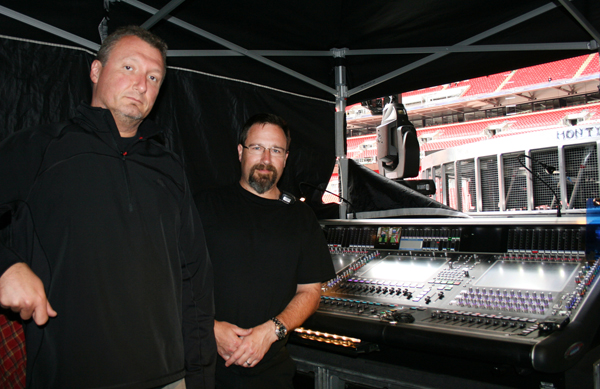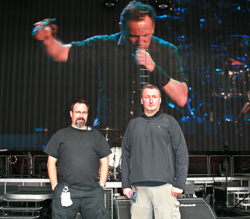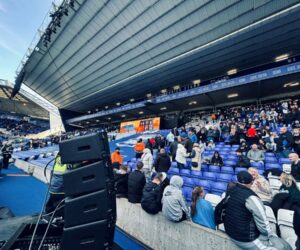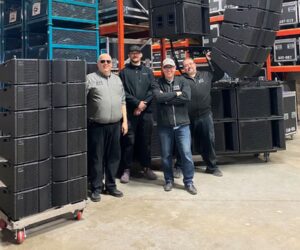Troy Milner and Monty Carlo have worked seamlessly side-by-side for more than a decade as monitor engineers, riding the faders for Bruce Springsteen and his 17-piece E-Street Band at stage left and stage right respectively – and they wouldn’t have it any other way. I recently caught up with the dynamic duo backstage prior to a show at London’s Wembley Stadium.
Paul Watson: So, four hands are better than two, then?
Troy Milner: I guess so! [laughs] We are completely independent of each other though; we each get our own splits, and we each have our own set of stage racks and Waves servers.
Monty Carlo: With 18 people on stage, it’s pretty involved, and with Bruce, you never know – he does a set list but he doesn’t follow it, ever, so we’re always on our toes!
TM: They’ve actually always had two monitor engineers. Monty’s been here a lot longer, and I joined on in 2000. It’s actually the way they’ve always liked it for 20-plus years, but we can do a lot more now due to the technology advancements.
How does your partnership work, exactly?
TM: Well, I take care of the drummer, the violin player, the guitarist, the bassist, and the keyboard player who is right here next to me; then I deal with various wedges that are located around the stage for some solos for Bruce.
MC: I hadle pretty much everybody else, really. We each have a lot going on and there are a lot of cues for each song; and again, as Bruce doesn’t follow the set list, well…
I can’t see any wedges on stage – where are you hiding them?
MC: [smiles] There are a number of proprietary Solotech wedges imbedded in the stage, a mixture of double 12s, single 12s and single 15s, and we’re using JBL VT4888s for side fills. The rest of the band is on in-ears, but Bruce is completely old school.

What in-ear systems are you running, and do you have any RF issues?
TM: We use Shure kit, PSM1000 IEM systems and the Axient wireless mics, which we like a lot. The boxes underneath are Albatross headphone amps that I use for the drummer – he’s hard wired. When he sits down he plugs right into his seat on his left side and never moves, so he doesn’t need to be wireless.
MC: We have 70 channels of RF between backline and myself and Troy, and although here [in the UK] it’s not too bad, when we’re in Italy… Well, it’s notorious for RF issues. Thankfully, the kit we’re using makes life a whole lot easier than it could be!
What does Bruce like to hear in his wedges?
MC: He’s got a little bit of everything – it’s so tough as each musician has their own wants and needs, but with Bruce, I just kind of fill it up around him between the side fills and the floor wedges so that he hears everything. I have everything panned to make it feel more “live” – the piano is coming from his left and the organ from the right, and the same with the horns, just to kind of open things up, and so he knows where it’s all coming from.
And after all these years, Bruce is still on a classic Shure SM58 capsule.
MC: Absolutely – it still does the job great. We’ve tried a few different things, but it’s still the best sounding and most reliable solution. Also, when it rains and Bruce is out running through the crowd, we don’t have to worry about it falling apart. You can build a house with it.
You both mix on DiGiCo SD7s. Is it essential that you’re on the same console?
TM: For our setup, absolutely. We have snapshots for all of the songs, and I’m up to 205. There are some songs that I know Bruce won’t do, but every one is programmed for me on the snapshots. I couldn’t do that without the SD7.
MC: On the whole, the SD7 has been really flexible. It’s also great for moving stuff around. Troy double-assigns the drums so the drummer has his own set of drum inputs and the rest of the band has their own set too, so in terms of tailoring things quickly, everything’s just so easy to do on this desk.
TM: That’s right, the drummer is a little more demanding, so I kind of mix him old school; the control groups are pretty static for him. I’ll hammer him with certain parts that he just wants to hear. For example, he might want two bars of the opening riff from the guitar player, then he wants to get rid of it, so I have to be very hands-on. Monty’s obviously got different stuff that he handles, too.





















